Logistic and Supply Chain Management in Aston Martin
VerifiedAdded on 2022/12/15
|10
|3407
|346
AI Summary
This report explores the logistic and supply chain management in Aston Martin, a British manufacturing organization. It discusses how logistic and supply chain management is conceived, supported, delivered, and developed in Aston Martin. The report covers various aspects such as customer service, transportation, warehousing, and competitive advantage. It also discusses different supply chain management models and concepts. Subject: Supply Chain Management, Course Code: N/A, Course Name: N/A, College/University: N/A
Contribute Materials
Your contribution can guide someone’s learning journey. Share your
documents today.
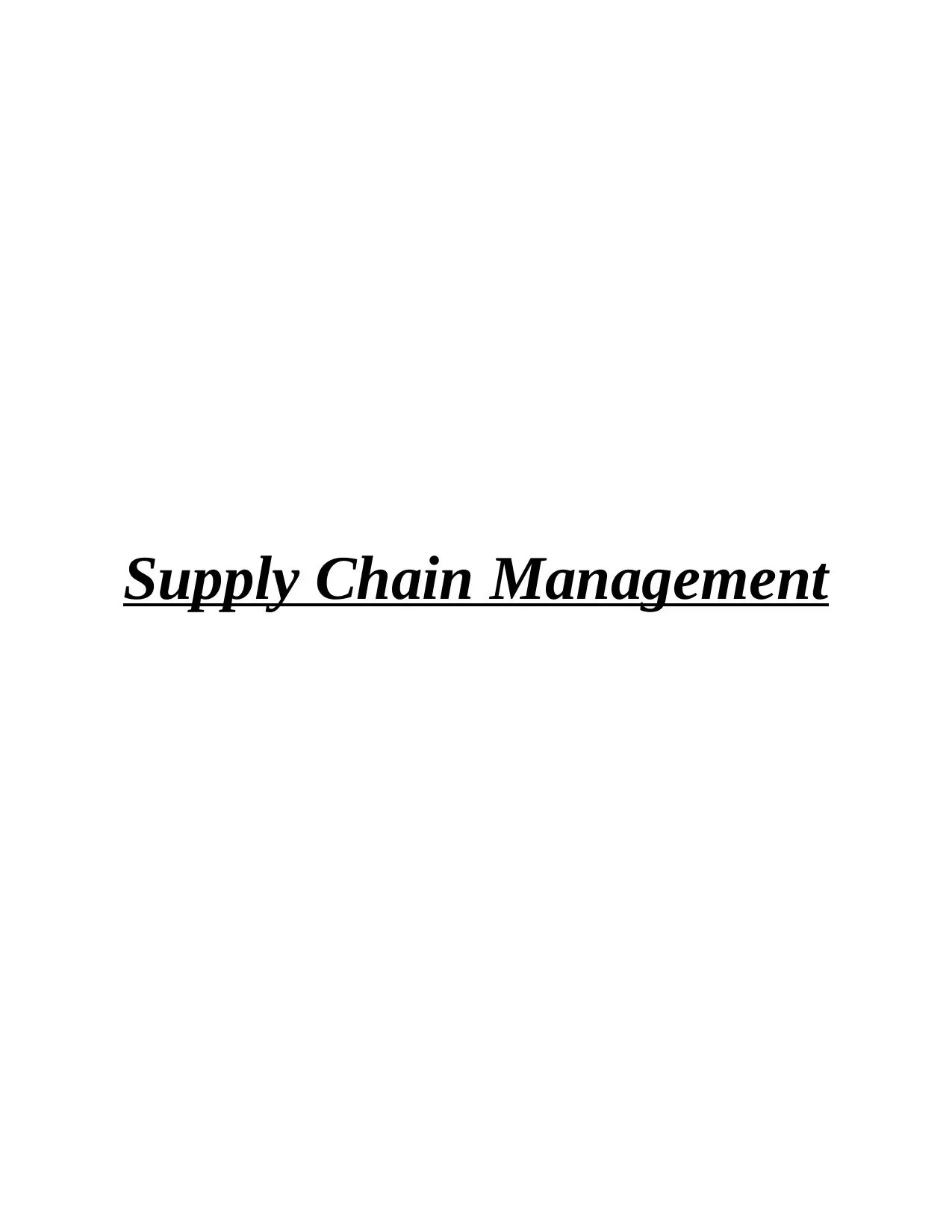
Supply Chain Management
Secure Best Marks with AI Grader
Need help grading? Try our AI Grader for instant feedback on your assignments.
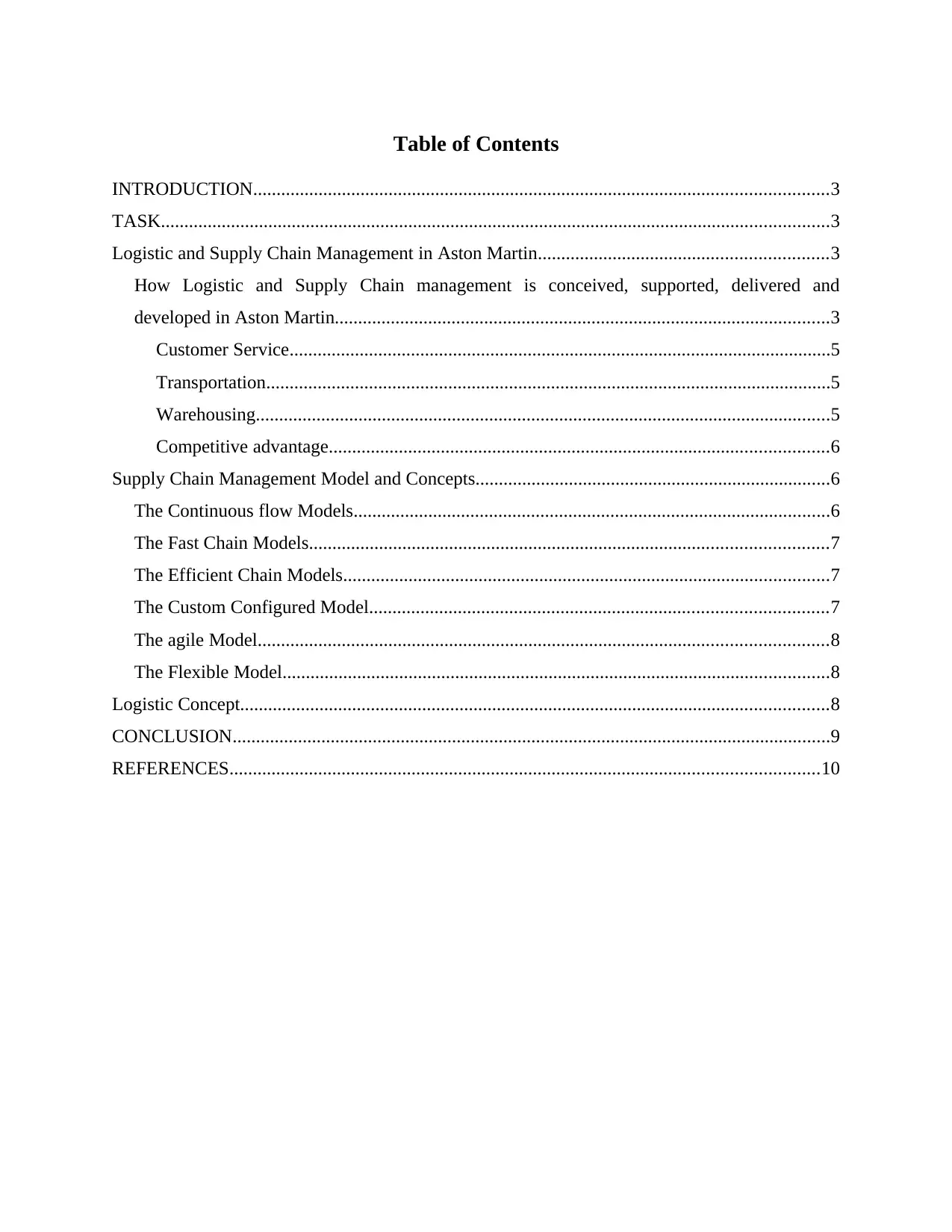
Table of Contents
INTRODUCTION...........................................................................................................................3
TASK...............................................................................................................................................3
Logistic and Supply Chain Management in Aston Martin..............................................................3
How Logistic and Supply Chain management is conceived, supported, delivered and
developed in Aston Martin..........................................................................................................3
Customer Service....................................................................................................................5
Transportation.........................................................................................................................5
Warehousing...........................................................................................................................5
Competitive advantage...........................................................................................................6
Supply Chain Management Model and Concepts............................................................................6
The Continuous flow Models......................................................................................................6
The Fast Chain Models...............................................................................................................7
The Efficient Chain Models........................................................................................................7
The Custom Configured Model..................................................................................................7
The agile Model..........................................................................................................................8
The Flexible Model.....................................................................................................................8
Logistic Concept..............................................................................................................................8
CONCLUSION................................................................................................................................9
REFERENCES..............................................................................................................................10
INTRODUCTION...........................................................................................................................3
TASK...............................................................................................................................................3
Logistic and Supply Chain Management in Aston Martin..............................................................3
How Logistic and Supply Chain management is conceived, supported, delivered and
developed in Aston Martin..........................................................................................................3
Customer Service....................................................................................................................5
Transportation.........................................................................................................................5
Warehousing...........................................................................................................................5
Competitive advantage...........................................................................................................6
Supply Chain Management Model and Concepts............................................................................6
The Continuous flow Models......................................................................................................6
The Fast Chain Models...............................................................................................................7
The Efficient Chain Models........................................................................................................7
The Custom Configured Model..................................................................................................7
The agile Model..........................................................................................................................8
The Flexible Model.....................................................................................................................8
Logistic Concept..............................................................................................................................8
CONCLUSION................................................................................................................................9
REFERENCES..............................................................................................................................10
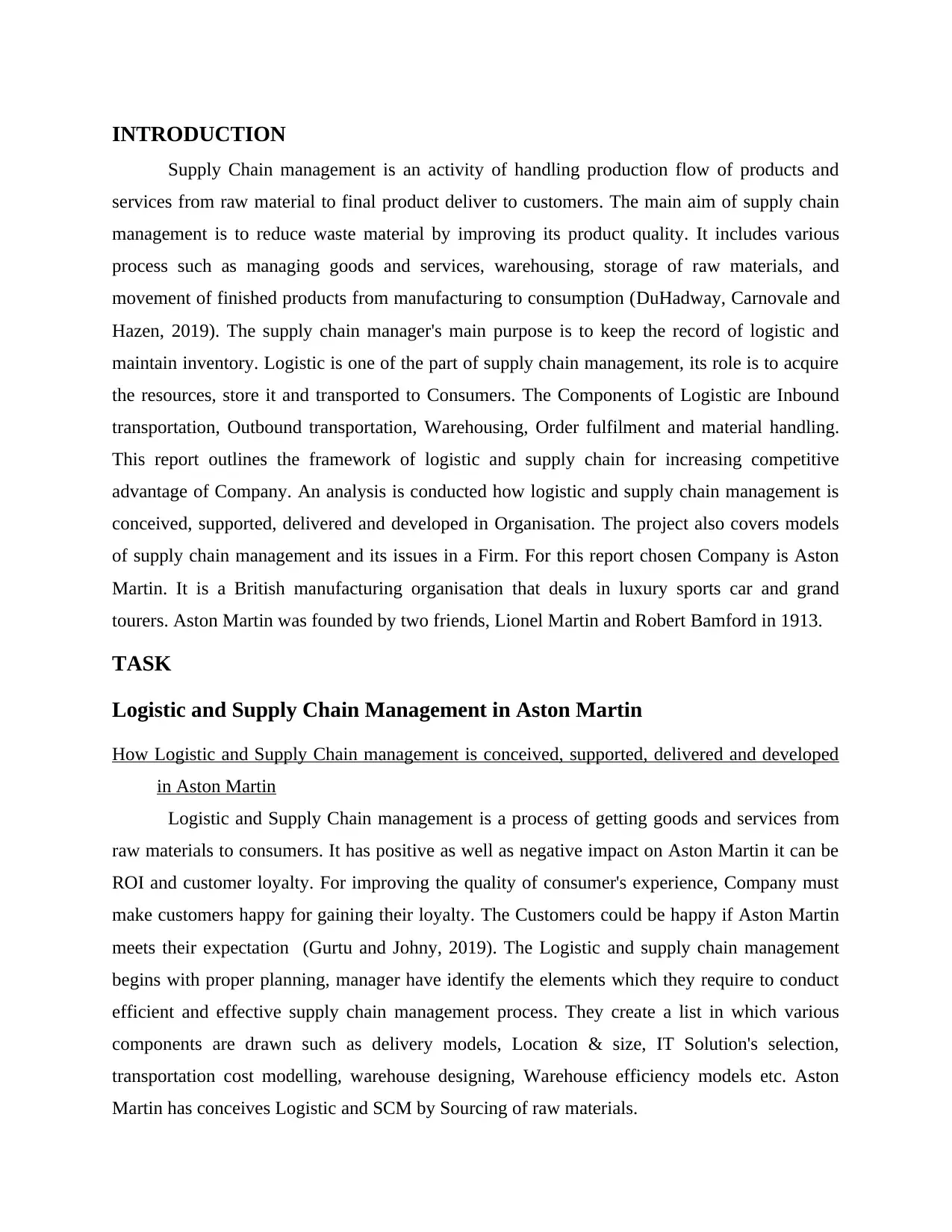
INTRODUCTION
Supply Chain management is an activity of handling production flow of products and
services from raw material to final product deliver to customers. The main aim of supply chain
management is to reduce waste material by improving its product quality. It includes various
process such as managing goods and services, warehousing, storage of raw materials, and
movement of finished products from manufacturing to consumption (DuHadway, Carnovale and
Hazen, 2019). The supply chain manager's main purpose is to keep the record of logistic and
maintain inventory. Logistic is one of the part of supply chain management, its role is to acquire
the resources, store it and transported to Consumers. The Components of Logistic are Inbound
transportation, Outbound transportation, Warehousing, Order fulfilment and material handling.
This report outlines the framework of logistic and supply chain for increasing competitive
advantage of Company. An analysis is conducted how logistic and supply chain management is
conceived, supported, delivered and developed in Organisation. The project also covers models
of supply chain management and its issues in a Firm. For this report chosen Company is Aston
Martin. It is a British manufacturing organisation that deals in luxury sports car and grand
tourers. Aston Martin was founded by two friends, Lionel Martin and Robert Bamford in 1913.
TASK
Logistic and Supply Chain Management in Aston Martin
How Logistic and Supply Chain management is conceived, supported, delivered and developed
in Aston Martin
Logistic and Supply Chain management is a process of getting goods and services from
raw materials to consumers. It has positive as well as negative impact on Aston Martin it can be
ROI and customer loyalty. For improving the quality of consumer's experience, Company must
make customers happy for gaining their loyalty. The Customers could be happy if Aston Martin
meets their expectation (Gurtu and Johny, 2019). The Logistic and supply chain management
begins with proper planning, manager have identify the elements which they require to conduct
efficient and effective supply chain management process. They create a list in which various
components are drawn such as delivery models, Location & size, IT Solution's selection,
transportation cost modelling, warehouse designing, Warehouse efficiency models etc. Aston
Martin has conceives Logistic and SCM by Sourcing of raw materials.
Supply Chain management is an activity of handling production flow of products and
services from raw material to final product deliver to customers. The main aim of supply chain
management is to reduce waste material by improving its product quality. It includes various
process such as managing goods and services, warehousing, storage of raw materials, and
movement of finished products from manufacturing to consumption (DuHadway, Carnovale and
Hazen, 2019). The supply chain manager's main purpose is to keep the record of logistic and
maintain inventory. Logistic is one of the part of supply chain management, its role is to acquire
the resources, store it and transported to Consumers. The Components of Logistic are Inbound
transportation, Outbound transportation, Warehousing, Order fulfilment and material handling.
This report outlines the framework of logistic and supply chain for increasing competitive
advantage of Company. An analysis is conducted how logistic and supply chain management is
conceived, supported, delivered and developed in Organisation. The project also covers models
of supply chain management and its issues in a Firm. For this report chosen Company is Aston
Martin. It is a British manufacturing organisation that deals in luxury sports car and grand
tourers. Aston Martin was founded by two friends, Lionel Martin and Robert Bamford in 1913.
TASK
Logistic and Supply Chain Management in Aston Martin
How Logistic and Supply Chain management is conceived, supported, delivered and developed
in Aston Martin
Logistic and Supply Chain management is a process of getting goods and services from
raw materials to consumers. It has positive as well as negative impact on Aston Martin it can be
ROI and customer loyalty. For improving the quality of consumer's experience, Company must
make customers happy for gaining their loyalty. The Customers could be happy if Aston Martin
meets their expectation (Gurtu and Johny, 2019). The Logistic and supply chain management
begins with proper planning, manager have identify the elements which they require to conduct
efficient and effective supply chain management process. They create a list in which various
components are drawn such as delivery models, Location & size, IT Solution's selection,
transportation cost modelling, warehouse designing, Warehouse efficiency models etc. Aston
Martin has conceives Logistic and SCM by Sourcing of raw materials.
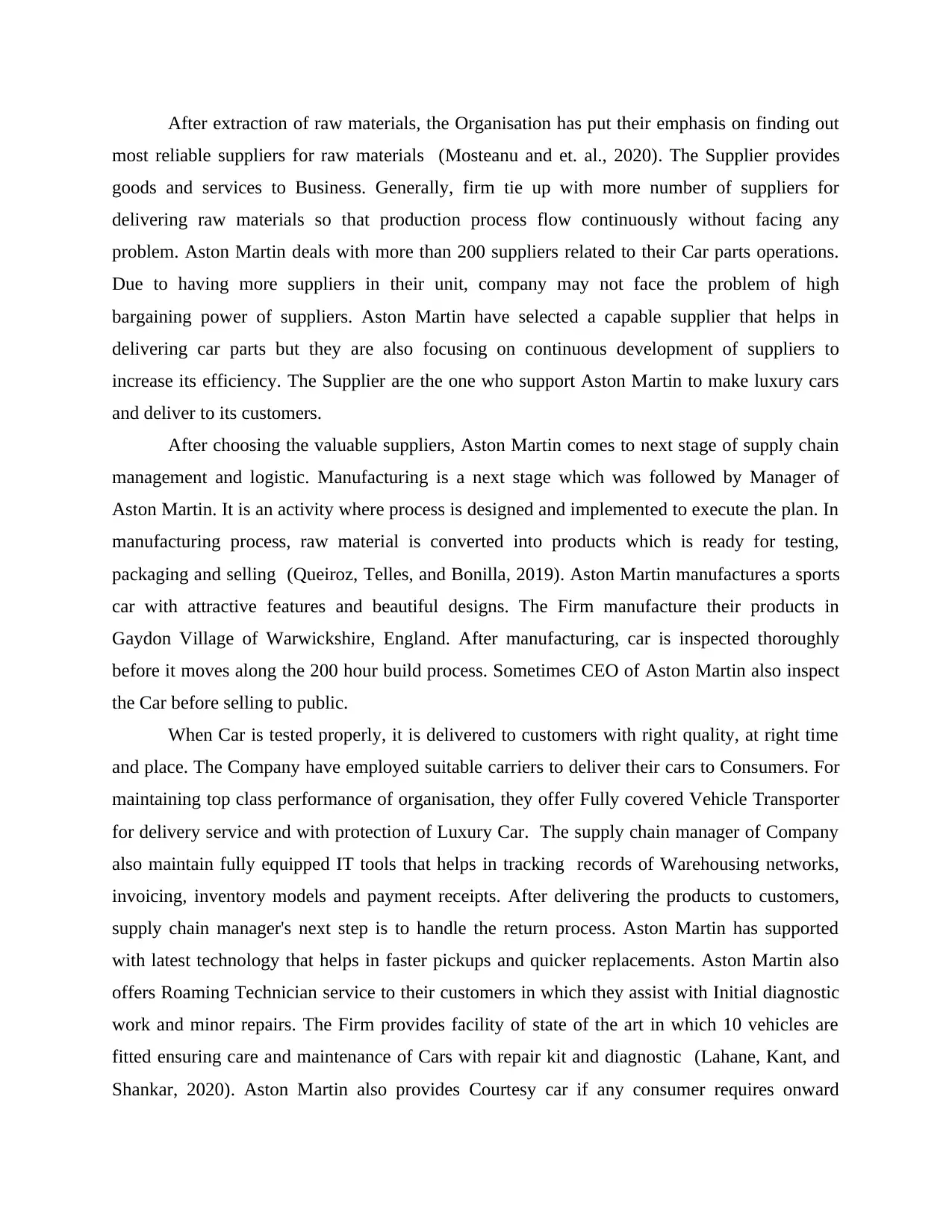
After extraction of raw materials, the Organisation has put their emphasis on finding out
most reliable suppliers for raw materials (Mosteanu and et. al., 2020). The Supplier provides
goods and services to Business. Generally, firm tie up with more number of suppliers for
delivering raw materials so that production process flow continuously without facing any
problem. Aston Martin deals with more than 200 suppliers related to their Car parts operations.
Due to having more suppliers in their unit, company may not face the problem of high
bargaining power of suppliers. Aston Martin have selected a capable supplier that helps in
delivering car parts but they are also focusing on continuous development of suppliers to
increase its efficiency. The Supplier are the one who support Aston Martin to make luxury cars
and deliver to its customers.
After choosing the valuable suppliers, Aston Martin comes to next stage of supply chain
management and logistic. Manufacturing is a next stage which was followed by Manager of
Aston Martin. It is an activity where process is designed and implemented to execute the plan. In
manufacturing process, raw material is converted into products which is ready for testing,
packaging and selling (Queiroz, Telles, and Bonilla, 2019). Aston Martin manufactures a sports
car with attractive features and beautiful designs. The Firm manufacture their products in
Gaydon Village of Warwickshire, England. After manufacturing, car is inspected thoroughly
before it moves along the 200 hour build process. Sometimes CEO of Aston Martin also inspect
the Car before selling to public.
When Car is tested properly, it is delivered to customers with right quality, at right time
and place. The Company have employed suitable carriers to deliver their cars to Consumers. For
maintaining top class performance of organisation, they offer Fully covered Vehicle Transporter
for delivery service and with protection of Luxury Car. The supply chain manager of Company
also maintain fully equipped IT tools that helps in tracking records of Warehousing networks,
invoicing, inventory models and payment receipts. After delivering the products to customers,
supply chain manager's next step is to handle the return process. Aston Martin has supported
with latest technology that helps in faster pickups and quicker replacements. Aston Martin also
offers Roaming Technician service to their customers in which they assist with Initial diagnostic
work and minor repairs. The Firm provides facility of state of the art in which 10 vehicles are
fitted ensuring care and maintenance of Cars with repair kit and diagnostic (Lahane, Kant, and
Shankar, 2020). Aston Martin also provides Courtesy car if any consumer requires onward
most reliable suppliers for raw materials (Mosteanu and et. al., 2020). The Supplier provides
goods and services to Business. Generally, firm tie up with more number of suppliers for
delivering raw materials so that production process flow continuously without facing any
problem. Aston Martin deals with more than 200 suppliers related to their Car parts operations.
Due to having more suppliers in their unit, company may not face the problem of high
bargaining power of suppliers. Aston Martin have selected a capable supplier that helps in
delivering car parts but they are also focusing on continuous development of suppliers to
increase its efficiency. The Supplier are the one who support Aston Martin to make luxury cars
and deliver to its customers.
After choosing the valuable suppliers, Aston Martin comes to next stage of supply chain
management and logistic. Manufacturing is a next stage which was followed by Manager of
Aston Martin. It is an activity where process is designed and implemented to execute the plan. In
manufacturing process, raw material is converted into products which is ready for testing,
packaging and selling (Queiroz, Telles, and Bonilla, 2019). Aston Martin manufactures a sports
car with attractive features and beautiful designs. The Firm manufacture their products in
Gaydon Village of Warwickshire, England. After manufacturing, car is inspected thoroughly
before it moves along the 200 hour build process. Sometimes CEO of Aston Martin also inspect
the Car before selling to public.
When Car is tested properly, it is delivered to customers with right quality, at right time
and place. The Company have employed suitable carriers to deliver their cars to Consumers. For
maintaining top class performance of organisation, they offer Fully covered Vehicle Transporter
for delivery service and with protection of Luxury Car. The supply chain manager of Company
also maintain fully equipped IT tools that helps in tracking records of Warehousing networks,
invoicing, inventory models and payment receipts. After delivering the products to customers,
supply chain manager's next step is to handle the return process. Aston Martin has supported
with latest technology that helps in faster pickups and quicker replacements. Aston Martin also
offers Roaming Technician service to their customers in which they assist with Initial diagnostic
work and minor repairs. The Firm provides facility of state of the art in which 10 vehicles are
fitted ensuring care and maintenance of Cars with repair kit and diagnostic (Lahane, Kant, and
Shankar, 2020). Aston Martin also provides Courtesy car if any consumer requires onward
Secure Best Marks with AI Grader
Need help grading? Try our AI Grader for instant feedback on your assignments.
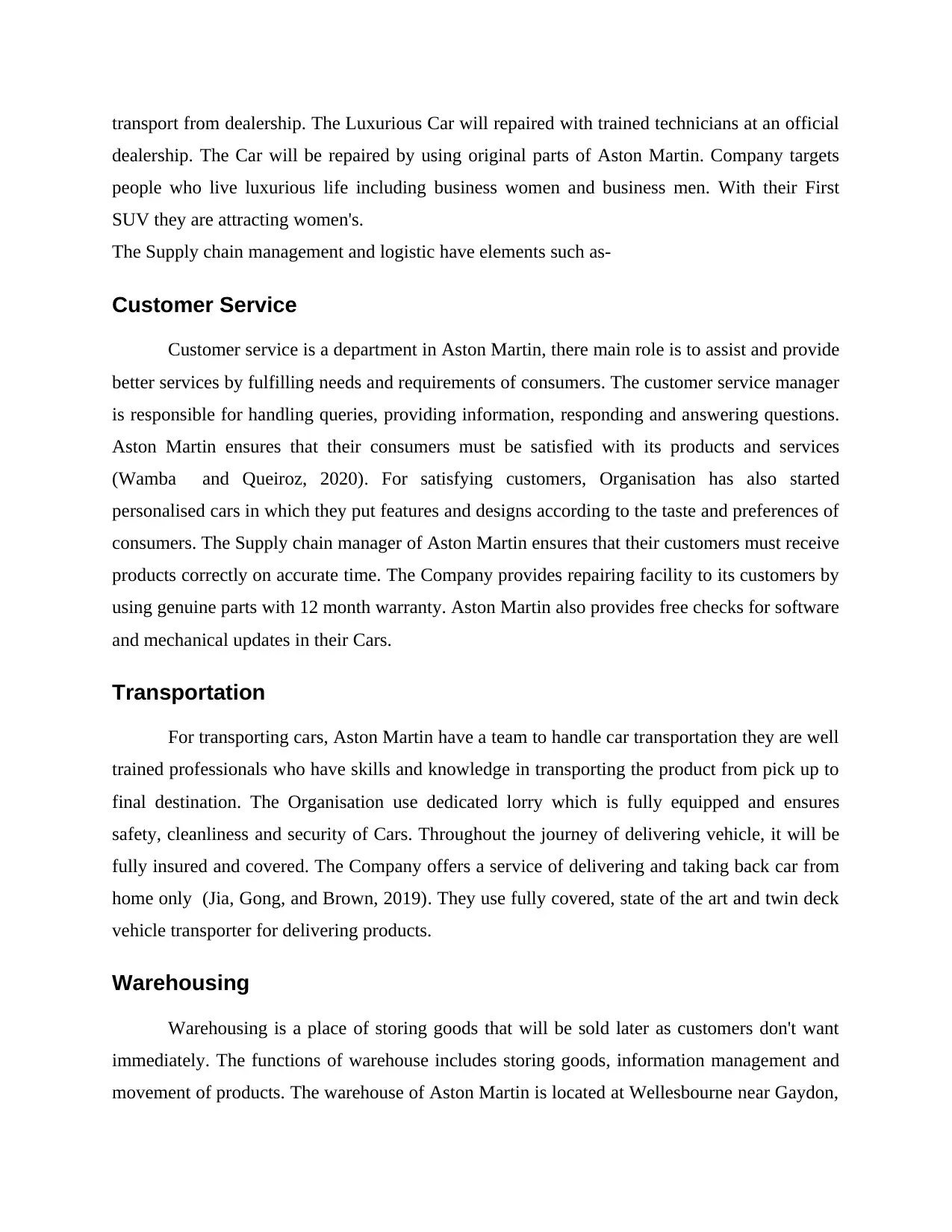
transport from dealership. The Luxurious Car will repaired with trained technicians at an official
dealership. The Car will be repaired by using original parts of Aston Martin. Company targets
people who live luxurious life including business women and business men. With their First
SUV they are attracting women's.
The Supply chain management and logistic have elements such as-
Customer Service
Customer service is a department in Aston Martin, there main role is to assist and provide
better services by fulfilling needs and requirements of consumers. The customer service manager
is responsible for handling queries, providing information, responding and answering questions.
Aston Martin ensures that their consumers must be satisfied with its products and services
(Wamba and Queiroz, 2020). For satisfying customers, Organisation has also started
personalised cars in which they put features and designs according to the taste and preferences of
consumers. The Supply chain manager of Aston Martin ensures that their customers must receive
products correctly on accurate time. The Company provides repairing facility to its customers by
using genuine parts with 12 month warranty. Aston Martin also provides free checks for software
and mechanical updates in their Cars.
Transportation
For transporting cars, Aston Martin have a team to handle car transportation they are well
trained professionals who have skills and knowledge in transporting the product from pick up to
final destination. The Organisation use dedicated lorry which is fully equipped and ensures
safety, cleanliness and security of Cars. Throughout the journey of delivering vehicle, it will be
fully insured and covered. The Company offers a service of delivering and taking back car from
home only (Jia, Gong, and Brown, 2019). They use fully covered, state of the art and twin deck
vehicle transporter for delivering products.
Warehousing
Warehousing is a place of storing goods that will be sold later as customers don't want
immediately. The functions of warehouse includes storing goods, information management and
movement of products. The warehouse of Aston Martin is located at Wellesbourne near Gaydon,
dealership. The Car will be repaired by using original parts of Aston Martin. Company targets
people who live luxurious life including business women and business men. With their First
SUV they are attracting women's.
The Supply chain management and logistic have elements such as-
Customer Service
Customer service is a department in Aston Martin, there main role is to assist and provide
better services by fulfilling needs and requirements of consumers. The customer service manager
is responsible for handling queries, providing information, responding and answering questions.
Aston Martin ensures that their consumers must be satisfied with its products and services
(Wamba and Queiroz, 2020). For satisfying customers, Organisation has also started
personalised cars in which they put features and designs according to the taste and preferences of
consumers. The Supply chain manager of Aston Martin ensures that their customers must receive
products correctly on accurate time. The Company provides repairing facility to its customers by
using genuine parts with 12 month warranty. Aston Martin also provides free checks for software
and mechanical updates in their Cars.
Transportation
For transporting cars, Aston Martin have a team to handle car transportation they are well
trained professionals who have skills and knowledge in transporting the product from pick up to
final destination. The Organisation use dedicated lorry which is fully equipped and ensures
safety, cleanliness and security of Cars. Throughout the journey of delivering vehicle, it will be
fully insured and covered. The Company offers a service of delivering and taking back car from
home only (Jia, Gong, and Brown, 2019). They use fully covered, state of the art and twin deck
vehicle transporter for delivering products.
Warehousing
Warehousing is a place of storing goods that will be sold later as customers don't want
immediately. The functions of warehouse includes storing goods, information management and
movement of products. The warehouse of Aston Martin is located at Wellesbourne near Gaydon,
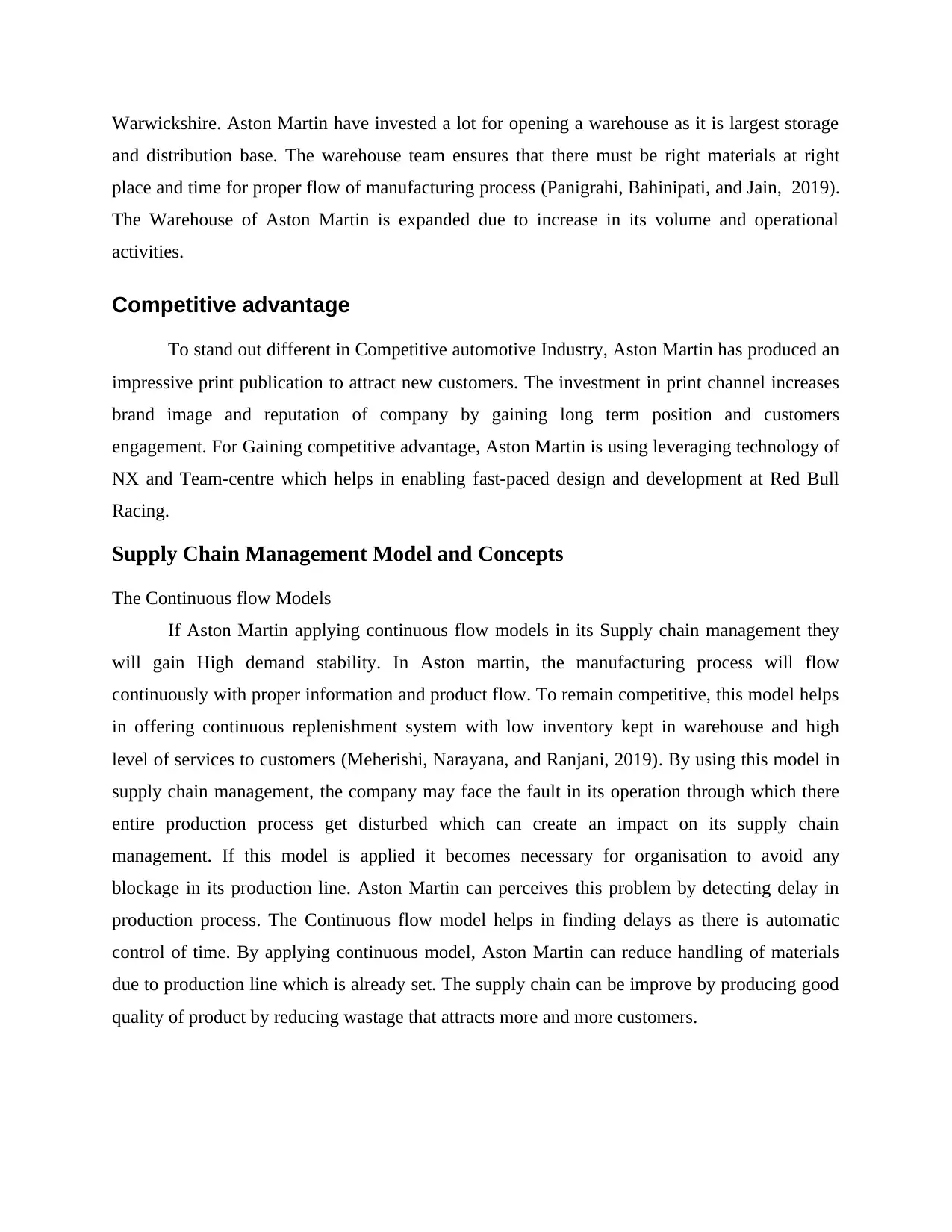
Warwickshire. Aston Martin have invested a lot for opening a warehouse as it is largest storage
and distribution base. The warehouse team ensures that there must be right materials at right
place and time for proper flow of manufacturing process (Panigrahi, Bahinipati, and Jain, 2019).
The Warehouse of Aston Martin is expanded due to increase in its volume and operational
activities.
Competitive advantage
To stand out different in Competitive automotive Industry, Aston Martin has produced an
impressive print publication to attract new customers. The investment in print channel increases
brand image and reputation of company by gaining long term position and customers
engagement. For Gaining competitive advantage, Aston Martin is using leveraging technology of
NX and Team-centre which helps in enabling fast-paced design and development at Red Bull
Racing.
Supply Chain Management Model and Concepts
The Continuous flow Models
If Aston Martin applying continuous flow models in its Supply chain management they
will gain High demand stability. In Aston martin, the manufacturing process will flow
continuously with proper information and product flow. To remain competitive, this model helps
in offering continuous replenishment system with low inventory kept in warehouse and high
level of services to customers (Meherishi, Narayana, and Ranjani, 2019). By using this model in
supply chain management, the company may face the fault in its operation through which there
entire production process get disturbed which can create an impact on its supply chain
management. If this model is applied it becomes necessary for organisation to avoid any
blockage in its production line. Aston Martin can perceives this problem by detecting delay in
production process. The Continuous flow model helps in finding delays as there is automatic
control of time. By applying continuous model, Aston Martin can reduce handling of materials
due to production line which is already set. The supply chain can be improve by producing good
quality of product by reducing wastage that attracts more and more customers.
and distribution base. The warehouse team ensures that there must be right materials at right
place and time for proper flow of manufacturing process (Panigrahi, Bahinipati, and Jain, 2019).
The Warehouse of Aston Martin is expanded due to increase in its volume and operational
activities.
Competitive advantage
To stand out different in Competitive automotive Industry, Aston Martin has produced an
impressive print publication to attract new customers. The investment in print channel increases
brand image and reputation of company by gaining long term position and customers
engagement. For Gaining competitive advantage, Aston Martin is using leveraging technology of
NX and Team-centre which helps in enabling fast-paced design and development at Red Bull
Racing.
Supply Chain Management Model and Concepts
The Continuous flow Models
If Aston Martin applying continuous flow models in its Supply chain management they
will gain High demand stability. In Aston martin, the manufacturing process will flow
continuously with proper information and product flow. To remain competitive, this model helps
in offering continuous replenishment system with low inventory kept in warehouse and high
level of services to customers (Meherishi, Narayana, and Ranjani, 2019). By using this model in
supply chain management, the company may face the fault in its operation through which there
entire production process get disturbed which can create an impact on its supply chain
management. If this model is applied it becomes necessary for organisation to avoid any
blockage in its production line. Aston Martin can perceives this problem by detecting delay in
production process. The Continuous flow model helps in finding delays as there is automatic
control of time. By applying continuous model, Aston Martin can reduce handling of materials
due to production line which is already set. The supply chain can be improve by producing good
quality of product by reducing wastage that attracts more and more customers.
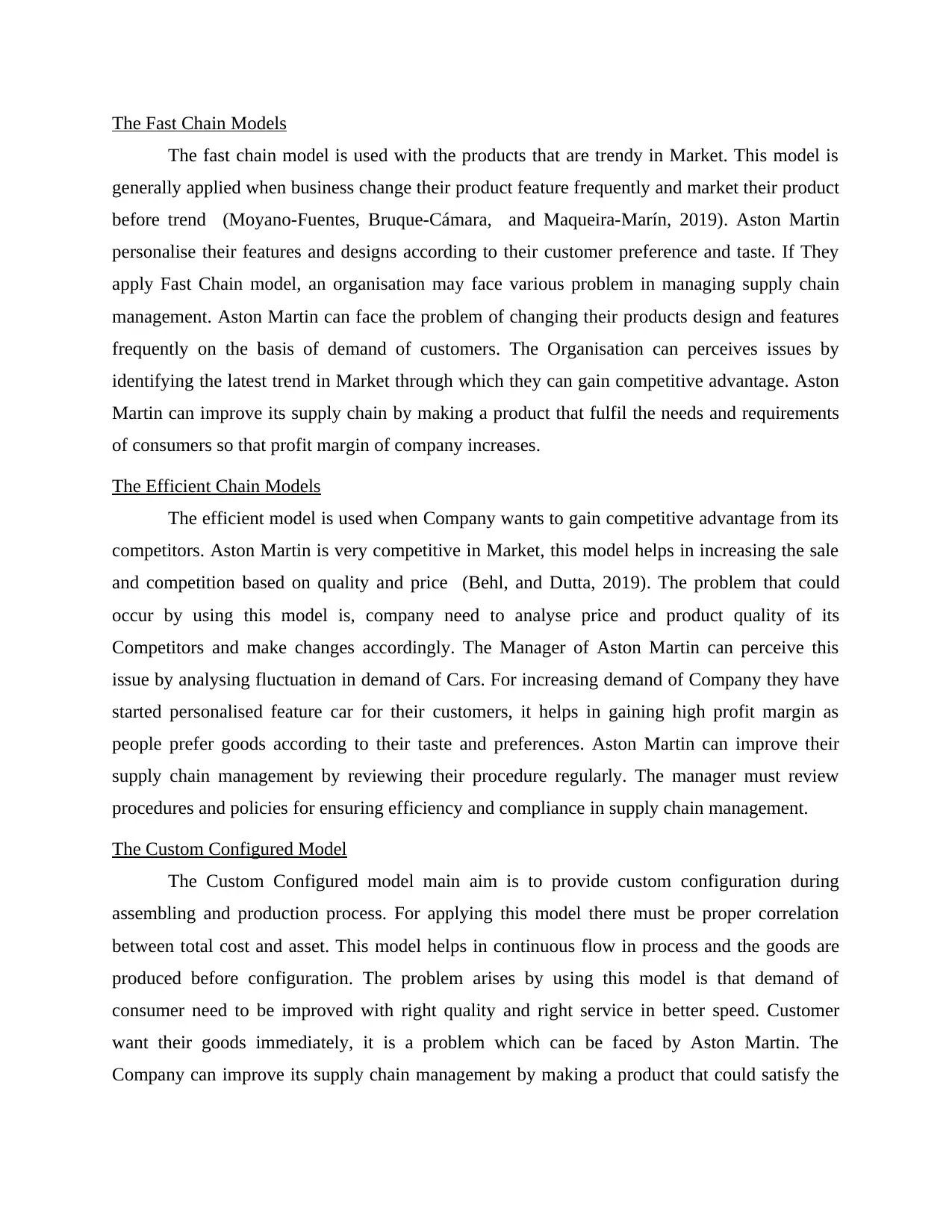
The Fast Chain Models
The fast chain model is used with the products that are trendy in Market. This model is
generally applied when business change their product feature frequently and market their product
before trend (Moyano-Fuentes, Bruque-Cámara, and Maqueira-Marín, 2019). Aston Martin
personalise their features and designs according to their customer preference and taste. If They
apply Fast Chain model, an organisation may face various problem in managing supply chain
management. Aston Martin can face the problem of changing their products design and features
frequently on the basis of demand of customers. The Organisation can perceives issues by
identifying the latest trend in Market through which they can gain competitive advantage. Aston
Martin can improve its supply chain by making a product that fulfil the needs and requirements
of consumers so that profit margin of company increases.
The Efficient Chain Models
The efficient model is used when Company wants to gain competitive advantage from its
competitors. Aston Martin is very competitive in Market, this model helps in increasing the sale
and competition based on quality and price (Behl, and Dutta, 2019). The problem that could
occur by using this model is, company need to analyse price and product quality of its
Competitors and make changes accordingly. The Manager of Aston Martin can perceive this
issue by analysing fluctuation in demand of Cars. For increasing demand of Company they have
started personalised feature car for their customers, it helps in gaining high profit margin as
people prefer goods according to their taste and preferences. Aston Martin can improve their
supply chain management by reviewing their procedure regularly. The manager must review
procedures and policies for ensuring efficiency and compliance in supply chain management.
The Custom Configured Model
The Custom Configured model main aim is to provide custom configuration during
assembling and production process. For applying this model there must be proper correlation
between total cost and asset. This model helps in continuous flow in process and the goods are
produced before configuration. The problem arises by using this model is that demand of
consumer need to be improved with right quality and right service in better speed. Customer
want their goods immediately, it is a problem which can be faced by Aston Martin. The
Company can improve its supply chain management by making a product that could satisfy the
The fast chain model is used with the products that are trendy in Market. This model is
generally applied when business change their product feature frequently and market their product
before trend (Moyano-Fuentes, Bruque-Cámara, and Maqueira-Marín, 2019). Aston Martin
personalise their features and designs according to their customer preference and taste. If They
apply Fast Chain model, an organisation may face various problem in managing supply chain
management. Aston Martin can face the problem of changing their products design and features
frequently on the basis of demand of customers. The Organisation can perceives issues by
identifying the latest trend in Market through which they can gain competitive advantage. Aston
Martin can improve its supply chain by making a product that fulfil the needs and requirements
of consumers so that profit margin of company increases.
The Efficient Chain Models
The efficient model is used when Company wants to gain competitive advantage from its
competitors. Aston Martin is very competitive in Market, this model helps in increasing the sale
and competition based on quality and price (Behl, and Dutta, 2019). The problem that could
occur by using this model is, company need to analyse price and product quality of its
Competitors and make changes accordingly. The Manager of Aston Martin can perceive this
issue by analysing fluctuation in demand of Cars. For increasing demand of Company they have
started personalised feature car for their customers, it helps in gaining high profit margin as
people prefer goods according to their taste and preferences. Aston Martin can improve their
supply chain management by reviewing their procedure regularly. The manager must review
procedures and policies for ensuring efficiency and compliance in supply chain management.
The Custom Configured Model
The Custom Configured model main aim is to provide custom configuration during
assembling and production process. For applying this model there must be proper correlation
between total cost and asset. This model helps in continuous flow in process and the goods are
produced before configuration. The problem arises by using this model is that demand of
consumer need to be improved with right quality and right service in better speed. Customer
want their goods immediately, it is a problem which can be faced by Aston Martin. The
Company can improve its supply chain management by making a product that could satisfy the
Paraphrase This Document
Need a fresh take? Get an instant paraphrase of this document with our AI Paraphraser
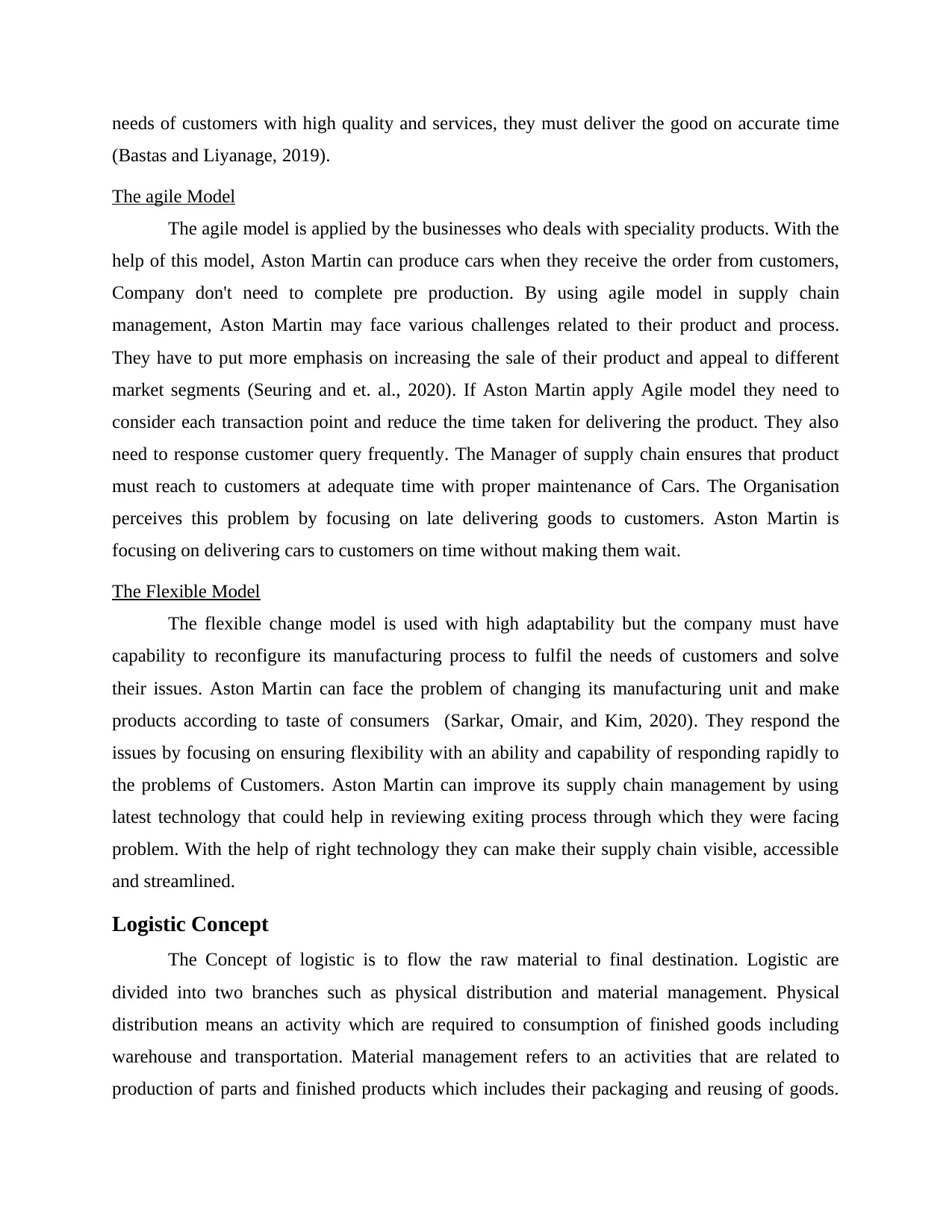
needs of customers with high quality and services, they must deliver the good on accurate time
(Bastas and Liyanage, 2019).
The agile Model
The agile model is applied by the businesses who deals with speciality products. With the
help of this model, Aston Martin can produce cars when they receive the order from customers,
Company don't need to complete pre production. By using agile model in supply chain
management, Aston Martin may face various challenges related to their product and process.
They have to put more emphasis on increasing the sale of their product and appeal to different
market segments (Seuring and et. al., 2020). If Aston Martin apply Agile model they need to
consider each transaction point and reduce the time taken for delivering the product. They also
need to response customer query frequently. The Manager of supply chain ensures that product
must reach to customers at adequate time with proper maintenance of Cars. The Organisation
perceives this problem by focusing on late delivering goods to customers. Aston Martin is
focusing on delivering cars to customers on time without making them wait.
The Flexible Model
The flexible change model is used with high adaptability but the company must have
capability to reconfigure its manufacturing process to fulfil the needs of customers and solve
their issues. Aston Martin can face the problem of changing its manufacturing unit and make
products according to taste of consumers (Sarkar, Omair, and Kim, 2020). They respond the
issues by focusing on ensuring flexibility with an ability and capability of responding rapidly to
the problems of Customers. Aston Martin can improve its supply chain management by using
latest technology that could help in reviewing exiting process through which they were facing
problem. With the help of right technology they can make their supply chain visible, accessible
and streamlined.
Logistic Concept
The Concept of logistic is to flow the raw material to final destination. Logistic are
divided into two branches such as physical distribution and material management. Physical
distribution means an activity which are required to consumption of finished goods including
warehouse and transportation. Material management refers to an activities that are related to
production of parts and finished products which includes their packaging and reusing of goods.
(Bastas and Liyanage, 2019).
The agile Model
The agile model is applied by the businesses who deals with speciality products. With the
help of this model, Aston Martin can produce cars when they receive the order from customers,
Company don't need to complete pre production. By using agile model in supply chain
management, Aston Martin may face various challenges related to their product and process.
They have to put more emphasis on increasing the sale of their product and appeal to different
market segments (Seuring and et. al., 2020). If Aston Martin apply Agile model they need to
consider each transaction point and reduce the time taken for delivering the product. They also
need to response customer query frequently. The Manager of supply chain ensures that product
must reach to customers at adequate time with proper maintenance of Cars. The Organisation
perceives this problem by focusing on late delivering goods to customers. Aston Martin is
focusing on delivering cars to customers on time without making them wait.
The Flexible Model
The flexible change model is used with high adaptability but the company must have
capability to reconfigure its manufacturing process to fulfil the needs of customers and solve
their issues. Aston Martin can face the problem of changing its manufacturing unit and make
products according to taste of consumers (Sarkar, Omair, and Kim, 2020). They respond the
issues by focusing on ensuring flexibility with an ability and capability of responding rapidly to
the problems of Customers. Aston Martin can improve its supply chain management by using
latest technology that could help in reviewing exiting process through which they were facing
problem. With the help of right technology they can make their supply chain visible, accessible
and streamlined.
Logistic Concept
The Concept of logistic is to flow the raw material to final destination. Logistic are
divided into two branches such as physical distribution and material management. Physical
distribution means an activity which are required to consumption of finished goods including
warehouse and transportation. Material management refers to an activities that are related to
production of parts and finished products which includes their packaging and reusing of goods.
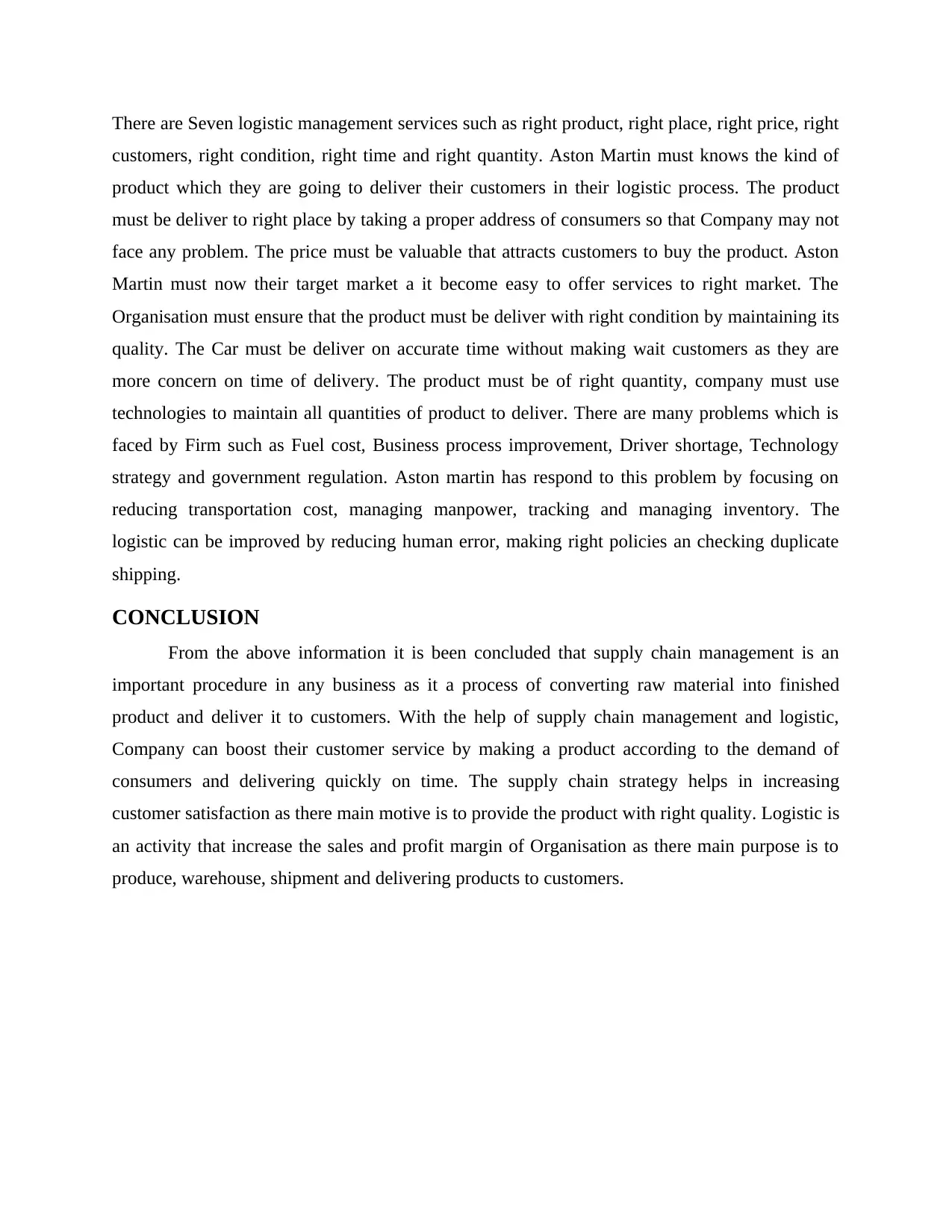
There are Seven logistic management services such as right product, right place, right price, right
customers, right condition, right time and right quantity. Aston Martin must knows the kind of
product which they are going to deliver their customers in their logistic process. The product
must be deliver to right place by taking a proper address of consumers so that Company may not
face any problem. The price must be valuable that attracts customers to buy the product. Aston
Martin must now their target market a it become easy to offer services to right market. The
Organisation must ensure that the product must be deliver with right condition by maintaining its
quality. The Car must be deliver on accurate time without making wait customers as they are
more concern on time of delivery. The product must be of right quantity, company must use
technologies to maintain all quantities of product to deliver. There are many problems which is
faced by Firm such as Fuel cost, Business process improvement, Driver shortage, Technology
strategy and government regulation. Aston martin has respond to this problem by focusing on
reducing transportation cost, managing manpower, tracking and managing inventory. The
logistic can be improved by reducing human error, making right policies an checking duplicate
shipping.
CONCLUSION
From the above information it is been concluded that supply chain management is an
important procedure in any business as it a process of converting raw material into finished
product and deliver it to customers. With the help of supply chain management and logistic,
Company can boost their customer service by making a product according to the demand of
consumers and delivering quickly on time. The supply chain strategy helps in increasing
customer satisfaction as there main motive is to provide the product with right quality. Logistic is
an activity that increase the sales and profit margin of Organisation as there main purpose is to
produce, warehouse, shipment and delivering products to customers.
customers, right condition, right time and right quantity. Aston Martin must knows the kind of
product which they are going to deliver their customers in their logistic process. The product
must be deliver to right place by taking a proper address of consumers so that Company may not
face any problem. The price must be valuable that attracts customers to buy the product. Aston
Martin must now their target market a it become easy to offer services to right market. The
Organisation must ensure that the product must be deliver with right condition by maintaining its
quality. The Car must be deliver on accurate time without making wait customers as they are
more concern on time of delivery. The product must be of right quantity, company must use
technologies to maintain all quantities of product to deliver. There are many problems which is
faced by Firm such as Fuel cost, Business process improvement, Driver shortage, Technology
strategy and government regulation. Aston martin has respond to this problem by focusing on
reducing transportation cost, managing manpower, tracking and managing inventory. The
logistic can be improved by reducing human error, making right policies an checking duplicate
shipping.
CONCLUSION
From the above information it is been concluded that supply chain management is an
important procedure in any business as it a process of converting raw material into finished
product and deliver it to customers. With the help of supply chain management and logistic,
Company can boost their customer service by making a product according to the demand of
consumers and delivering quickly on time. The supply chain strategy helps in increasing
customer satisfaction as there main motive is to provide the product with right quality. Logistic is
an activity that increase the sales and profit margin of Organisation as there main purpose is to
produce, warehouse, shipment and delivering products to customers.
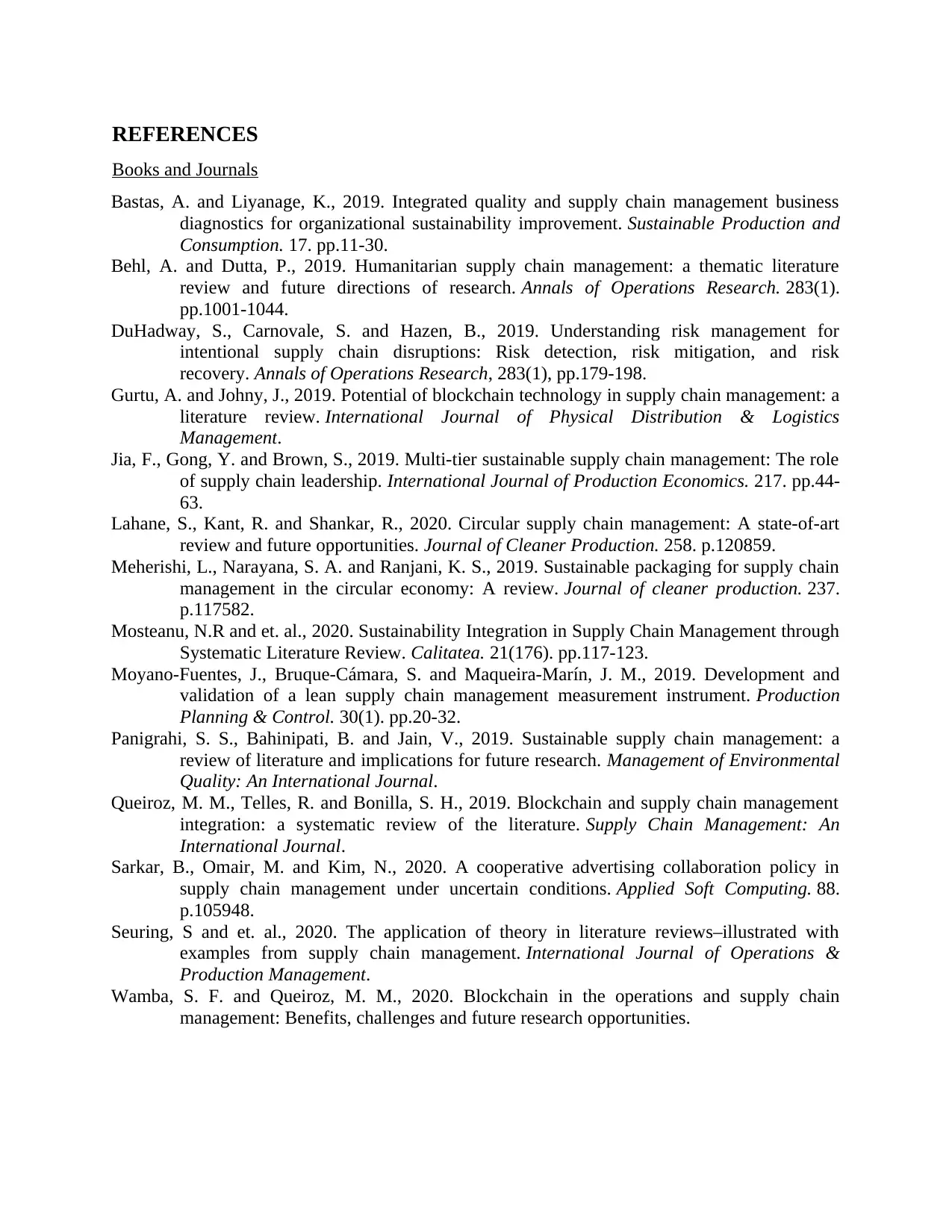
REFERENCES
Books and Journals
Bastas, A. and Liyanage, K., 2019. Integrated quality and supply chain management business
diagnostics for organizational sustainability improvement. Sustainable Production and
Consumption. 17. pp.11-30.
Behl, A. and Dutta, P., 2019. Humanitarian supply chain management: a thematic literature
review and future directions of research. Annals of Operations Research. 283(1).
pp.1001-1044.
DuHadway, S., Carnovale, S. and Hazen, B., 2019. Understanding risk management for
intentional supply chain disruptions: Risk detection, risk mitigation, and risk
recovery. Annals of Operations Research, 283(1), pp.179-198.
Gurtu, A. and Johny, J., 2019. Potential of blockchain technology in supply chain management: a
literature review. International Journal of Physical Distribution & Logistics
Management.
Jia, F., Gong, Y. and Brown, S., 2019. Multi-tier sustainable supply chain management: The role
of supply chain leadership. International Journal of Production Economics. 217. pp.44-
63.
Lahane, S., Kant, R. and Shankar, R., 2020. Circular supply chain management: A state-of-art
review and future opportunities. Journal of Cleaner Production. 258. p.120859.
Meherishi, L., Narayana, S. A. and Ranjani, K. S., 2019. Sustainable packaging for supply chain
management in the circular economy: A review. Journal of cleaner production. 237.
p.117582.
Mosteanu, N.R and et. al., 2020. Sustainability Integration in Supply Chain Management through
Systematic Literature Review. Calitatea. 21(176). pp.117-123.
Moyano-Fuentes, J., Bruque-Cámara, S. and Maqueira-Marín, J. M., 2019. Development and
validation of a lean supply chain management measurement instrument. Production
Planning & Control. 30(1). pp.20-32.
Panigrahi, S. S., Bahinipati, B. and Jain, V., 2019. Sustainable supply chain management: a
review of literature and implications for future research. Management of Environmental
Quality: An International Journal.
Queiroz, M. M., Telles, R. and Bonilla, S. H., 2019. Blockchain and supply chain management
integration: a systematic review of the literature. Supply Chain Management: An
International Journal.
Sarkar, B., Omair, M. and Kim, N., 2020. A cooperative advertising collaboration policy in
supply chain management under uncertain conditions. Applied Soft Computing. 88.
p.105948.
Seuring, S and et. al., 2020. The application of theory in literature reviews–illustrated with
examples from supply chain management. International Journal of Operations &
Production Management.
Wamba, S. F. and Queiroz, M. M., 2020. Blockchain in the operations and supply chain
management: Benefits, challenges and future research opportunities.
Books and Journals
Bastas, A. and Liyanage, K., 2019. Integrated quality and supply chain management business
diagnostics for organizational sustainability improvement. Sustainable Production and
Consumption. 17. pp.11-30.
Behl, A. and Dutta, P., 2019. Humanitarian supply chain management: a thematic literature
review and future directions of research. Annals of Operations Research. 283(1).
pp.1001-1044.
DuHadway, S., Carnovale, S. and Hazen, B., 2019. Understanding risk management for
intentional supply chain disruptions: Risk detection, risk mitigation, and risk
recovery. Annals of Operations Research, 283(1), pp.179-198.
Gurtu, A. and Johny, J., 2019. Potential of blockchain technology in supply chain management: a
literature review. International Journal of Physical Distribution & Logistics
Management.
Jia, F., Gong, Y. and Brown, S., 2019. Multi-tier sustainable supply chain management: The role
of supply chain leadership. International Journal of Production Economics. 217. pp.44-
63.
Lahane, S., Kant, R. and Shankar, R., 2020. Circular supply chain management: A state-of-art
review and future opportunities. Journal of Cleaner Production. 258. p.120859.
Meherishi, L., Narayana, S. A. and Ranjani, K. S., 2019. Sustainable packaging for supply chain
management in the circular economy: A review. Journal of cleaner production. 237.
p.117582.
Mosteanu, N.R and et. al., 2020. Sustainability Integration in Supply Chain Management through
Systematic Literature Review. Calitatea. 21(176). pp.117-123.
Moyano-Fuentes, J., Bruque-Cámara, S. and Maqueira-Marín, J. M., 2019. Development and
validation of a lean supply chain management measurement instrument. Production
Planning & Control. 30(1). pp.20-32.
Panigrahi, S. S., Bahinipati, B. and Jain, V., 2019. Sustainable supply chain management: a
review of literature and implications for future research. Management of Environmental
Quality: An International Journal.
Queiroz, M. M., Telles, R. and Bonilla, S. H., 2019. Blockchain and supply chain management
integration: a systematic review of the literature. Supply Chain Management: An
International Journal.
Sarkar, B., Omair, M. and Kim, N., 2020. A cooperative advertising collaboration policy in
supply chain management under uncertain conditions. Applied Soft Computing. 88.
p.105948.
Seuring, S and et. al., 2020. The application of theory in literature reviews–illustrated with
examples from supply chain management. International Journal of Operations &
Production Management.
Wamba, S. F. and Queiroz, M. M., 2020. Blockchain in the operations and supply chain
management: Benefits, challenges and future research opportunities.
1 out of 10
Related Documents
Your All-in-One AI-Powered Toolkit for Academic Success.
+13062052269
info@desklib.com
Available 24*7 on WhatsApp / Email
![[object Object]](/_next/static/media/star-bottom.7253800d.svg)
Unlock your academic potential
© 2024 | Zucol Services PVT LTD | All rights reserved.




